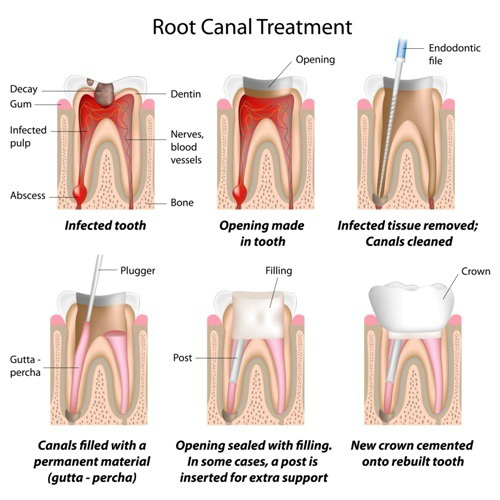ROOT CANAL TREATMENT
“Endodontics” derives from the Greek words “endo,” which means “inside,” and “odont,” which means tooth. So, the word ‘endodontics’ means to treat the inside of a tooth.
Often, the goal of Root Canal treatment is to save the tooth. Instead of simply pulling a diseased or damaged tooth, the dentist clears the infection and decay to protect the interior of the tooth from further damage.
During a root canal, we inject local anaesthesia on the gum tissue around the tooth and then remove the infected tissue and pulp from inside the tooth. The chamber, that held the pulp and the roots, is cleaned thoroughly with various solutions and medicaments to remove any remaining bacteria or organic matter. Once all traces of infection are gone and the interior of the tooth is fully dry, the dentist fills the chamber and roots with a special material called gutta-percha. Depending on how the exterior of the tooth looks, the dentist will finish the treatment by placing a crown or other type of dental restorations as per the customised requirement.
Recent advances in dental technology has produced the following advancements in root canal therapy:
Nickel Titanium Files — Stainless steel files used to clean out the root canals were susceptible to breakage and limited the amount of infection that could be removed. Now, we use nickel titanium files, which are more flexible with less breakage.
Anaesthesia — Current local anaesthetics make it easier to numb the entire tooth, so patients don’t feel any pain during the procedure.
Modern Dental Instruments — New high-torque motor hand pieces are much stronger and faster than before, enabling us to have more control over their dental instruments and better shape the root canal. Ultrasonic instruments are also being used during the root canal procedure which produce ultrasonic vibrations to clean the root in preparation for the filling.
X-Rays — Dentists may use X-rays several times during the procedure to check the status of the tooth. Digital X-rays not only produce less radiation, but are developed immediately, lessening the time you spend in the dental chair.
Apex Locators — Our goal during the procedure is to clean and fill the canal to the very end of the root, or apex. If we cannot find the apex, some of the infection may be left behind. An electronic apex locator measures the root, finding the apex through sound waves and guiding the dentist to the end of the root canal.
Cleaning and Filling the Canal — We take several measures to keep the infection from returning. Once the infection is removed, we use a medicated rinse to wash away any leftover debris and disinfect the tooth. Gutta percha, an antibacterial tooth filling material, better fills the canal, and non-allergenic dental sealers seal the space without irritating the tooth.


Apicoectomy
An apicoectomy is a surgery that removes the tip of a tooth’s roots.
An apicoectomy may be needed when an infection develops or persists after root canal treatment, or retreatment. During root canal treatment, the canals are cleaned, and inflamed or infected tissue is removed. Root canals are very complex, with many small branches off the main canal. Sometimes, even after root canal treatment, infected debris can remain in these branches and possibly prevent healing or cause re-infection later.
The main purpose of an apicoectomy is to save your tooth before the infection leads to compete destruction of the tooth making it necessary to perform an extraction. To avoid this, the dentist will remove the tip (apex) of the infected root to prevent the infection from spreading further. Once the area is cleaned, the dentist will seal the root.
An apicoectomy is sometimes called endodontic microsurgery because the procedure is done under an operating microscope.
Contact
- B-105, Tirth jyoti plaza, opp RTO gate, near subhash bridge circle, Ahmedabad, Gujarat 380027
- +91 96864 58860
- info@theauradent.com
